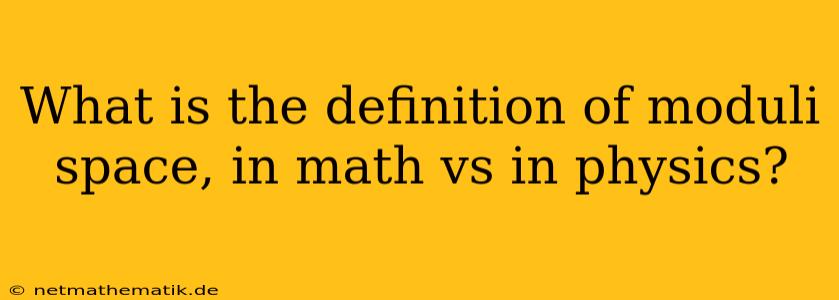The concept of moduli space, a fundamental tool in both mathematics and physics, provides a powerful framework for classifying and understanding geometric objects. It allows us to study the space of all possible configurations of a given system, encompassing different shapes, sizes, and other defining characteristics. While the underlying concept is shared, the specific interpretations and applications of moduli space diverge in mathematics and physics, leading to a fascinating interplay between the two disciplines.
Moduli Space in Mathematics: A Geometric Landscape
In mathematics, a moduli space is a geometric object that parameterizes a family of geometric objects. Each point in the moduli space corresponds to a specific geometric object in the family, and the space itself captures the relationships and variations among these objects. The objects can be incredibly diverse, ranging from curves and surfaces to higher-dimensional manifolds, bundles, and even complex structures.
Examples of Moduli Spaces in Mathematics:
1. Moduli Space of Elliptic Curves: One of the most fundamental examples is the moduli space of elliptic curves. An elliptic curve is a genus-one algebraic curve, which can be visualized as a torus or a donut shape. The moduli space of elliptic curves parameterizes all possible elliptic curves, with different points representing curves with different complex structures or shapes.
2. Moduli Space of Riemann Surfaces: Riemann surfaces are complex manifolds that play a crucial role in complex analysis and algebraic geometry. The moduli space of Riemann surfaces encapsulates all possible Riemann surfaces of a given genus, capturing their topological and geometric variations.
3. Moduli Space of Vector Bundles: Vector bundles, which are generalizations of tangent bundles on manifolds, play a significant role in topology and differential geometry. The moduli space of vector bundles classifies different vector bundles over a given base manifold, allowing us to study their stability and other properties.
Applications of Moduli Space in Mathematics:
- Classification of Geometric Objects: Moduli spaces provide a powerful tool for classifying and understanding the structure of different geometric objects.
- Study of Moduli Spaces: The properties of moduli spaces themselves are fascinating subjects of study, leading to deep connections between algebraic geometry, topology, and number theory.
- Geometric Invariants: Moduli spaces are used to define invariants, which are quantities that remain unchanged under certain transformations. These invariants provide essential insights into the underlying geometry of the objects being studied.
Moduli Space in Physics: A Landscape of Physical Systems
In physics, the concept of moduli space extends to parameterize different configurations of physical systems. This includes fields, particles, and even entire universes. Each point in the moduli space represents a specific configuration of the system, and the space itself encapsulates the dynamics and evolution of these configurations.
Examples of Moduli Space in Physics:
1. Moduli Space of String Theory: In string theory, a fundamental theory of quantum gravity, the moduli space describes the possible configurations of strings and branes. These configurations determine the geometry and topology of the underlying spacetime, leading to a wide variety of possible universes.
2. Moduli Space of Field Theories: In quantum field theory, moduli spaces are used to describe the possible vacuum states of the theory, which are the lowest energy configurations of the field. The moduli space of vacua can be complex and intricate, with different points representing different physical phases of the theory.
3. Moduli Space of Black Holes: In general relativity, moduli spaces are used to classify different types of black holes, including their mass, charge, and angular momentum. The moduli space of black holes provides insights into their stability and their behavior under perturbations.
Applications of Moduli Space in Physics:
- Understanding Physical Systems: Moduli spaces provide a framework for understanding the dynamics and evolution of physical systems, including the behavior of fields, particles, and even entire universes.
- Exploring New Theories: Moduli spaces are used to explore new theories of physics, such as string theory and quantum field theory, by classifying the possible configurations and dynamics of the underlying systems.
- Predicting Physical Phenomena: The study of moduli spaces can lead to predictions of new physical phenomena, such as the existence of different types of black holes or the emergence of new phases of matter.
The Intersection of Mathematics and Physics: A Fruitful Exchange
The concept of moduli space provides a fascinating bridge between mathematics and physics. Mathematics provides the rigorous framework for defining and studying moduli spaces, while physics provides the motivation and applications for their study. This fruitful exchange has led to significant advances in both fields, enriching our understanding of geometry, topology, string theory, quantum field theory, and more.
The study of moduli space continues to be an active area of research, with new discoveries and applications emerging constantly. As we delve deeper into the mysteries of the universe, the concept of moduli space will undoubtedly play an increasingly important role in our quest for a deeper understanding of the fundamental nature of reality.
